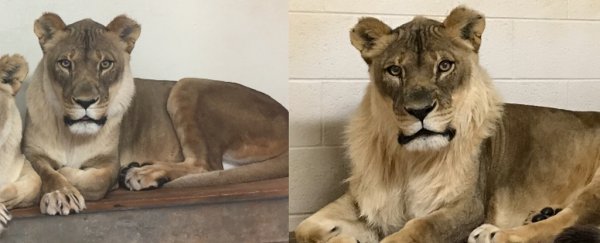Bridget, an 18-year-old lioness living at the Oklahoma City Zoo, has done something that has baffled her keepers.
After 17 years of a normal mane-free existence, she's sprouted a ruff of hair around her neck - a smaller version of the full mane usually sported by male lions.
As nothing has changed in Bridget's life, the zoo's veterinarians are at a loss to explain the new growth, which occurred between March and November 2017.
Bridget's sister Tia, also 18 years old, remains mane-free, while the zoo's male African lion continues to also have a mane without any changes.
As cubs, both male and female African lions don't have manes. Male lions tend to grow them when they reach about one year of age, due to increased production of the hormone testosterone. (If male lions are castrated, they actually lose their manes.)
Female lions have been observed in the wild not only growing manes to resemble male lions physically, their behaviour becomes more male too.
Five lionesses in Botswana were the subject of a 2016 study, and researchers observed them displaying both increased aggression and male mating behaviours.
It's difficult to know why those lionesses changed so drastically, but a lioness in captivity who also grew a mane a few years ago may hold a clue.
Emma, a lioness at the National Zoo of South Africa, grew a full mane at the age of 13 years. Zoo veterinarians removed her ovaries and conducted a skin biopsy.
Emma's chromosomes were normal, but her ovaries contained only cells usually found inside testicles - so, she was producing testosterone.
Much like a castrated male, after her ovaries were removed, Emma lost her mane and returned to normal.
But she had also birthed cubs in the past, which means that she must have had normal ovaries before, which at some point became more like testes.
Bridget has also birthed a litter of cubs, back in 2007, but the zoo is still searching for other explanations.
They have drawn a blood sample from her tail to check for a genetic condition, since the Botswana lionesses could be related, indicating a possible genetic cause.
They also think that a benign tumour on her adrenal or pituitary gland may be the cause, since both play a role in hormone regulation.
Despite the mystery however, they're not too worried about her health. Bridget is older than the median lion life expectancy of 16.9 years (these big cats tend to live longer in captivity), but otherwise seems fine.
"Zoo veterinary staff will continue to monitor her closely, but this condition is not likely to affect Bridget's quality of life," Oklahoma City Zoo staff explained in a blog post.
"They report that, other than the extra hair, they see no change in her health status."
